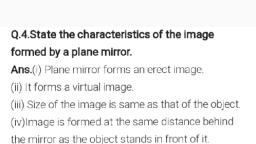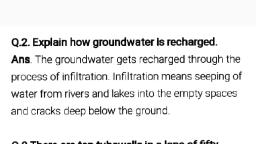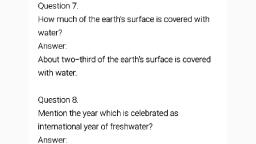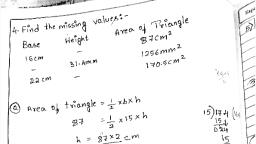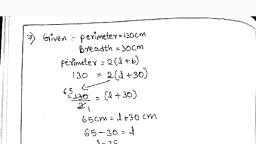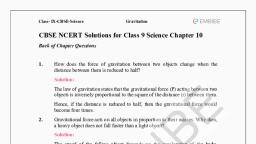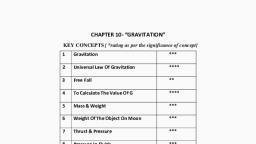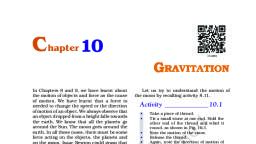Page 1 :
HEAL “cI wae +, , 1. State the universal law of gravitation ;, Ans: Every object in the universe sitracts every other object with some force, , which is directly proportional to the product of their masses and inversely, proportional to the square of the distance between them. The force acts along, , the line joining the centres of two objects., Let the two objects A and Bof masses Mand m lie at a distance d from, , each other, Lat the force of attraction between two objects be F., , A, B, P-?, <—4, p-oMm, =, , Where, G is the universal gravitation constant which is given by:, G =6.67«10" Nm'kg*, , 2. Write the formula to find the magnitude of the gravitational force, , between the earth and an object on the surface of the earth., Ans: Let the mass of the Earth be M and the mass of an object on its surface, , be m. If Ris the radius of the Earth, then according to the universal law of, gravitation, the gravitational force (F) that acts between the Earth and the, object can be given by the relation:, , 5 GMm, “Rr, , Scanned with CamScanner
Page 2 :
1, What do you mean by free fall?, , Ans; Each object is drawn towards the centre of the Earth by Its gravity,, When any object is released from a certain height, under the impact of, gravitational force, it falls to the Earth's surface. The movement of the object, ts said to be in free fall., , 2. What do you mean by acceleration due to gravity?, , Ans: When any object falls freely from a certain height towards the earth's, surface, its velocity changes with respect to time, This change in velocity, causes acceleration, This acceleration is known as the acceleration due to, , gravity (q). The value of acceleration due to gravity is 9.8ms*., , Intext Exercise 3, , 1, What are the differences between the mass of an object and its weight?, Ans: The difference between mass of an object and its weight Is given in the, the table below:, , , , Mass ___ Weight, Mass can be defined as the | Weight can be defined as, quantity of matter the force of gravity acting, contained in the body, on, the hady,, , , , It is the quantity that is a | |t is the quantity that is a, measure af inertia of the | measure of gravity,, , , , , , , , , , , , body., , Mass is constant everywhere. Value of weight varies at, different places,, , (tis a scalar quantity, Weight is a vector, , SI unit of mass is kg, SI unit of weight is N., , 2. Why is the weight of an object on the moon sth its weight on the, , earth?, Ans: Let the mass of the Earth be M, and the mass of an object on the, , surface of earth =m and the radius of earth R_., , Scanned with CamScanner
Page 3 :
According to the Universal law of gravitation, weight W, of the object on the, surface of the earth is given by,, GM,m, We= ET 4, e, Let M, and R,, be the mass and radius of the moon, Then, according to the, universal law of gravitation, weight W, of the object on the surface of the, moon is given by:, GM,m, Wy, = =, u, , So, ratio of weight of object on moon to weight on earth is, , Where, M, =5.98«10"*kg, , M,, = 7.3610" kg, , R, =6.4x10'm, , R,, =1.74«10'm, , Substituting the values in the ratio,, 2, , WwW, 7.3610" x (8.37 10°), >t =, W, 5.98x10" «(1.74x10")', , W, 1, —t =, =, = ’ 0.165 «5, , Hence, the weight of an object on the moon Is ath of Its weight on the Earth., , Intext Exercise 4, , 1, Why |s it difficult to hold a school bag having a strap made of a thin, and strong string?, Ans: Pressure can be given by the formula,, , F, P=—, A, , Pressure is inversely proportional to the surface area on which the force is, acting. The smaller is the surface area, the larger will be the pressure on the, , Scanned with CamScanner
Page 4 :
surface on which the force Is being acted upon. In the case of a thin strap of, the school bag, the contact surface area is very less. Hence, the pressure, exerted on the shoulder Is very high. Therefore, it becomes difficult to hold a, school bag with a thin strap., , 2, What do you mean by buoyancy?, Ans: The liquid exerts an upward force on any object when it is immersed in, , 4 liquid. The tendency of the liquid to exert such an upward force on the, object is called buoyancy, and the upward force which is exerted on the object, by the liquid is called the buoyant force,, , 3, Why does an abject float or sink when placed on the surface of water?, Ans: If the density of an object is greater than the density of liquid, it will, sink into the liquid. This is due to the buoyant force which is acted by the, object is less than the force of gravity., , On the contrary, if the density of object is less than the density of the liquid, it, floats on the liquid's surface. This is because the force that is acting on the, object is greater than the force of gravity, , Intext Exercise §, , 1, You find your mass to be 42 kg on a weighing machine, Is your mass, more or less than 42kg?, , Ans: An upward force acts on our body when we weigh our body while, standing on a weighing machine. The buoyant force Is this upward force, which Is acting. Consequently, the body is pushed up slightly, resulting in the, weighing machine showing lass reading than the real value., , 2. You have a bag of cotton and an iron bar, each indicating a mass of, 100kg when measured on a weighing machine, In reality, one is heavier, than other, Can you say which one Is heavier and why?, , Ans: Weight measured = Actual weight — buoyant force, , Therefore, Actual weight = Weight measured +buoyant force, , As the surface area of a cotton bag is greater than the iron bar, more buoyant, force acts on the bag than that on the iron bar, Hence, the mass of the cotton, bag is more than that of the iran bar,, , Scanned with CamScanner
Page 5 :
1. How does the force of gravitation between two objects change when the, distance between them is reduced to half?, , Ans: According to the universal law of gravitation, the gravitational force ( F), acting between two objacts of mass m,and m,, separated by a distance ‘f" is, given by, , p= Suh, , Where m,and m,are the masses of two bodies and ris the distance between, them, G is the universal gravitational constant., , When the distance Is reduced to half, Le., r’ =5, , are St, 4, oF SSn, Hence, if the distance is reduced to half, then the gravitational force becomes, four times that of the previous value., , 2. Gravitational force acts on all objects in proportion to their masses,, Why then, a heavy object does not fall faster than a light object?, , Ans; All the objects fall towards the ground with constant acceleration, called, acceleration due to gravity (if there is no air resistance present). |t is constant, and independent of the mass of the object. Hence, heavy objects do not fall, faster than light objects., , 3. What is the magnitude of the gravitational force between the earth and, @ lg object on its surface? (Mass of the earth is 6%10"kg and radius of, , the earth is 6.4x10*m)., Ans: According to the Universal law of gravitation, tha gravitational force, exerted on an object of mass mis given by:, , Scanned with CamScanner




